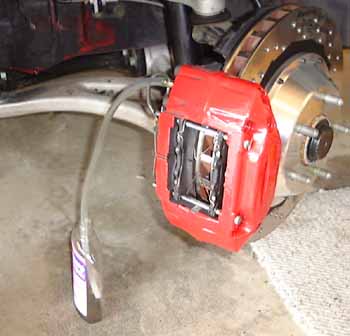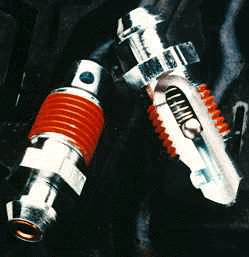How To Flush and Bleed the Brakes
By Rob Robinette
Brake bleeding is covered on page P-7 in the RX-7 Workshop Manual. You need
two people, one to operate the brake pedal and one to open and close the bleeder and top
off the brake fluid tank (unless you have speed bleeders). Use a proper brake-line wrench
for the bleeders (an 8mm wrench or socket works ok). You will need about 1 liter of brake
fluid for a complete flush. Don’t spill brake fluid on painted surfaces, if you do
clean it off immediately.

Clear line and bottle
connected to bleed nipple
To do a complete flush, start by sucking out as much of the
old fluid from the reservoir as possible with a vacuum pump. To drain the clutch half of
the reservoir disconnect the clutch line, it has a spring hose clamp that holds it to the
reservoir. Put some paper towels below the reservoir to catch any drips and use a bowl to
catch the clutch fluid. Reconnect the clutch line and then refill the reservoir with fresh
fluid.

Bleeding the clutch
(driver side of transmission)
Since the hydraulic clutch shares the reservoir with the
brakes you should go ahead and bleed the clutch too. The clutch nipple is on the driver
side of the clutch housing. You will have to access it from under the car. A good time to
do it is when you're bleeding the left front wheel.
Start at the wheel furthest (in hydraulic-circuit terms) from the master-cylinder and
progress toward the closest. The correct order for the 3rd gen RX-7 is right rear,
left rear, left front, right front.
Remove the brake/clutch reservoir cap. Remove the bleed nipple rubber cover and clean
the area around the nipple.
Installing and Using Speed Bleeders 
Speed bleeders make brake bleeding an easy and quick one man job. They have a one way
valve and sealed threads that prevent air from being sucked into the system during the
brake/clutch pedal up stroke. If you are installing Speed
Bleeders (highly recommended) just completely
unscrew the original bleeder nipple and screw in the speed bleeder. You will feel
resistance when the thread sealer starts to screw into the caliper. Torque the speed
bleeder to only 32-40 inch pounds (about 3 foot pounds). That's like
having a one foot long wrench with a 3 pound weight on it (not much torque). I stripped a
speed bleeder on my dirt bike (it didn't hurt the caliper's threads though) so go easy on
them. To use the speed bleeder fit a piece of clear tubing (so you can see the
bubbles and color of the fluid) over the bleed screw nipple and run the hose into a clear
bottle. Unscrew the Speed Bleeder about a 1/4 turn and go pump the brake/clutch pedal and
keep refilling the reservoir before it goes below the 3/4 mark. You don't need to know the
size of your bleeder nipples when you order speed bleeders, just tell them the year and
model of your car/motorcycle, they know what fits.
Bleeding Without Speed Bleeders
Fit a piece of clear tubing (so you can see the bubbles and color of the fluid)
over the bleed screw nipple and run the hose into a clear bottle. Ask your assistant to
step on the brake with light pressure. The pedal should only be moved through it’s
normal range of movement, not all the way to the floor.
Open the bleeder screw just enough to get fluid flowing, and before the fluid stops
flowing, close the bleeder. If you don't do it this way you may suck air into the lines
through the bleeder threads which will lead to a spongy brake pedal feel. Torque the
standard bleeder nipple to 53-86 inch pounds (about 5 foot pounds).
Repeat until clean/clear/bubbleless fluid comes out. Don't let the fluid tank go below
the 3/4 mark or air will be drawn into the system. It would take a lot of bleeding to get
a large amount of air out of the system when it enters at the reservoir, so be careful.
Move to the next closest wheel until all are done.
Ensure you have a nice firm brake pedal before you take the car off the jacks. Test the
brakes by moving the car slightly and apply the brakes and then continue to test the
brakes as you begin your test drive.
Rob Robinette
|


